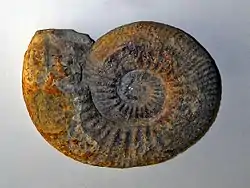Hammatoceras
Hammatoceras is a genus of ammonites belonging to the family Hammatoceratidae which lived during the Late Toarcian stage of the Early/Lower Jurassic between about 184 and 175 million year ago.[1]
| Hammatoceras | |
|---|---|
 | |
| Fossil of Hammatoceras porcarellense. Museum specimen | |
| Scientific classification | |
| Kingdom: | |
| Phylum: | |
| Class: | |
| Order: | |
| Family: | |
| Subfamily: | Hammatoceratinae |
| Genus: | Hammatoceras |
Taxonomy
Hammatoceras is included in the subfamily Hammatoceratinae, which in the outdated 1957 Treatise on Invertebrate Paleontology was part of the Hammatoceratidae, but of the Phymatoceratidae in D.T. Donovan et al., 1981, a case of what to base the family name on. Both accordingly contain the earlier Phytmatoceratinae and derived Hammatoceratinae. The superfamily Hammatoceratoidea in which the Hammatocaratidae and related families are currently placed is abandoned in favor of the older, equivalent, Hildoceratoidea. (M. K. Howarth. 2013)
Species
Species within this genus include:[2]
- Hammatoceras costulosum Merla, 1934
- Hammatoceras insigne Schubler, 1831
- Hammatoceras lorteti Dumortier, 1874
- Hammatoceras pachu Buckman, 1921
- Hammatoceras porcarellense Bonarelli, 1899 [3]
- Hammatoceras semilunatum Quenstedt, 1885
- Hammatoceras simulator Monestier, 1921
- Hammatoceras trigonatum Quenstedt, 1885
Fossil record
This genus is known in the fossil record in the Middle Jurassic, from 175.6 million years ago to about 171.6 million years ago. Fossil shells within this genus have been found in Canada, France, Germany, Hungary, Indonesia, Italy, Spain, Tunisia and the United Kingdom.[2]
Description
The shell of Hammatoceras varies from evolute to sub-involute, according to species and growth stage. All are compressed, i.e. discoidal, in form, with strong ribbing and a keeled ventor. Ribs arise from tubercles on the umbilical shoulder, the inner, dorso-lateral margin of the whorls, and bifurcate on the flanks, stopping at the ventral keel. Juvenile forms tend to be more evolute with more of the inner whorls showing, whereas mature forms tend to be more involute with outer whorls more strongly embracing.
References
- Sepkoski, Jack (2002). "A compendium of fossil marine animal genera (Cephalopoda entry)". Bulletins of American Paleontology. 363: 1–560. Archived from the original on 2008-05-07. Retrieved 2017-10-18.
- "Paleobiology Database - Hammatoceras". Retrieved 2017-10-19.
- WMSDB – Worldwide Mollusc Species Database
- W.J, Arkellet al., 1957. Mosozoic Ammonoidea. Treatise on Invertebrate Paleontology, Part L. Geological Society of America and University of Kansas Press.
- D.T.Donovan, J.H. Callomon, & M.K. Howarth, 1981. Classification of the Jurassic Ammonitina. The Ammonoidea, Systematics Association Special Volume no 18.
- Classification of Howarth 2013 from M. K. Howarth. 2013.
- Treatise on Invertebrate Paleontology, Part L, Revised, Volume 3B, Chapter 4: Psiloceratoidea, Eoderoceratoidea, Hildoceratoidea.
